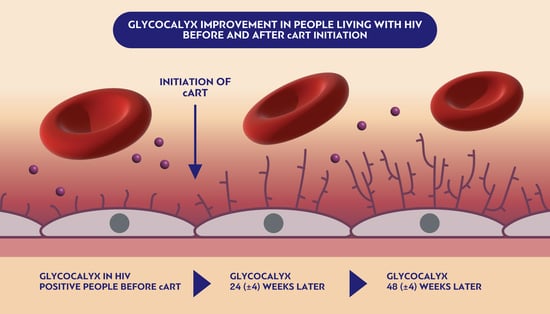Endothelial Glycocalyx Integrity in Treatment-Naïve People Living with HIV before and One Year after Antiretroviral Treatment Initiation
Abstract
1. Introduction
2. Materials and Methods
2.1. Study Design and Participant Selection
2.2. Scheduled Visits
2.3. Sample Collection
2.4. Routine Blood Tests
2.5. Biomarkers Measurement
2.6. Assessment of Endothelial Glycocalyx Thickness
2.7. Primary and Secondary Outcomes
2.8. Ethics Statement
2.9. Statistical Analysis
3. Results
3.1. Baseline Characteristics and Demographics
3.2. Clinical Data and Routine Laboratory Results
3.3. Levels of Biomarkers
3.4. Endothelial Glycocalyx Integrity Changes among All Participants after cART Initiation
3.5. Endothelial Glycocalyx Integrity according to Treatment Group
3.6. Endothelial Glycocalyx Integrity according to Sex
3.7. Endothelial Glycocalyx Integrity according to Nadir CD4+ Count and HIV Viral Load
3.8. Endothelial Glycocalyx Integrity according to Smoking Status and Illicit Drug Use
3.9. Correlation between Reduction in PBR5–25 over the First Year and Other Variables
4. Discussion
5. Conclusions
Author Contributions
Funding
Institutional Review Board Statement
Informed Consent Statement
Data Availability Statement
Conflicts of Interest
References
- Global HIV & AIDS Statistics—Fact Sheet|UNAIDS. Available online: https://www.unaids.org/en/resources/fact-sheet (accessed on 27 April 2023).
- Shah, A.S.V.; Stelzle, D.; Ken Lee, K.; Beck, E.J.; Alam, S.; Clifford, S.; Longenecker, C.T.; Strachan, F.; Bagchi, S.; Whiteley, W.; et al. Global Burden of Atherosclerotic Cardiovascular Disease in People Living with HIV Systematic Review and Meta-Analysis. Circulation 2018, 138, 1100–1112. [Google Scholar] [CrossRef]
- Hsue, P.Y.; Waters, D.D. Time to Recognize HIV Infection as a Major Cardiovascular Risk Factor. Circulation 2018, 138, 1113–1115. [Google Scholar] [CrossRef]
- Triant, V.A.; Lee, H.; Hadigan, C.; Grinspoon, S.K. Increased Acute Myocardial Infarction Rates and Cardiovascular Risk Factors among Patients with Human Immunodeficiency Virus Disease. J. Clin. Endocrinol. Metab. 2007, 92, 2506–2512. [Google Scholar] [CrossRef]
- Fragkou, P.C.; Moschopoulos, C.D.; Dimopoulou, D.; Triantafyllidi, H.; Birmpa, D.; Benas, D.; Tsiodras, S.; Kavatha, D.; Antoniadou, A.; Papadopoulos, A. Cardiovascular Disease and Risk Assessment in People Living with HIV: Current Practices and Novel Perspectives. Hellenic. J. Cardiol. 2023, 71, 42–54. [Google Scholar] [CrossRef]
- Sabin, C.A.; Worm, S.W.; Weber, R.; Reiss, P.; El-Sadr, W.; Dabis, F.; De Wit, S.; Law, M.; D’Arminio Monforte, A.; Friis-Møller, N.; et al. Use of Nucleoside Reverse Transcriptase Inhibitors and Risk of Myocardial Infarction in HIV-Infected Patients Enrolled in the D:A:D Study: A Multi-Cohort Collaboration. Lancet 2008, 371, 1417–1426. [Google Scholar] [CrossRef]
- Feinstein, M.J.; Bahiru, E.; Achenbach, C.; Longenecker, C.T.; Hsue, P.; So-Armah, K.; Freiberg, M.S.; Lloyd-Jones, D.M. Patterns of Cardiovascular Mortality for HIV-Infected Adults in the United States: 1999 to 2013. Am. J. Cardiol. 2016, 117, 214–220. [Google Scholar] [CrossRef]
- Schulz, C.A.; Mavarani, L.; Reinsch, N.; Albayrak-Rena, S.; Potthoff, A.; Brockmeyer, N.; Hower, M.; Erbel, R.; Jöckel, K.H.; Schmidt, B.; et al. Prediction of Future Cardiovascular Events by Framingham, SCORE and AsCVD Risk Scores Is Less Accurate in HIV-Positive Individuals from the HIV-HEART Study Compared with the General Population. HIV Med. 2021, 22, 732–741. [Google Scholar] [CrossRef]
- Perkins, M.V.; Joseph, S.B.; Dittmer, D.P.; Mackman, N. Cardiovascular Disease and Thrombosis in HIV Infection. Arterioscler. Thromb. Vasc. Biol. 2023, 43, 175–191. [Google Scholar] [CrossRef]
- Nou, E.; Lo, J.; Grinspoon, S.K. Inflammation, Immune Activation, and Cardiovascular Disease in HIV. AIDS 2016, 30, 1495–1509. [Google Scholar] [CrossRef]
- Alexander, Y.; Osto, E.; Schmidt-Trucksäss, A.; Shechter, M.; Trifunovic, D.; Duncker, D.J.; Aboyans, V.; Bäck, M.; Badimon, L.; Cosentino, F.; et al. Endothelial Function in Cardiovascular Medicine: A Consensus Paper of the European Society of Cardiology Working Groups on Atherosclerosis and Vascular Biology, Aorta and Peripheral Vascular Diseases, Coronary Pathophysiology and Microcirculation, and Thrombosis. Cardiovasc. Res. 2021, 117, 29–42. [Google Scholar] [CrossRef]
- Reitsma, S.; Slaaf, D.W.; Vink, H.; Van Zandvoort, M.A.M.J.; Oude Egbrink, M.G.A. The Endothelial Glycocalyx: Composition, Functions, and Visualization. Pflugers. Arch. 2007, 454, 345–359. [Google Scholar] [CrossRef]
- Suzuki, A.; TOMITA, H.; OKADA, H. Form Follows Function: The Endothelial Glycocalyx. Transl. Res. 2022, 247, 158–167. [Google Scholar] [CrossRef]
- Triantafyllidi, H.; Benas, D.; Vlachos, S.; Vlastos, D.; Pavlidis, G.; Schoinas, A.; Varoudi, M.; Birmpa, D.; Moutsatsou, P.; Lekakis, J.; et al. HDL Cholesterol Levels and Endothelial Glycocalyx Integrity in Treated Hypertensive Patients. J. Clin. Hypertens. 2018, 20, 1615–1623. [Google Scholar] [CrossRef]
- Belousoviene, E.; Kiudulaite, I.; Pilvinis, V.; Pranskunas, A. Links between Endothelial Glycocalyx Changes and Microcirculatory Parameters in Septic Patients. Life 2021, 11, 790. [Google Scholar] [CrossRef]
- European AIDS Clinical Society GUIDELINES Version 9.0. Available online: https://www.eacsociety.org/media/guidelines_9.0-english.pdf (accessed on 27 April 2023).
- European AIDS Clinical Society (EACS) GUIDELINES Version 9.1. Available online: https://www.eacsociety.org/media/2018_guidelines-9.1-english.pdf (accessed on 27 April 2023).
- European AIDS Clinical Society GUIDELINES Version 10. Available online: https://www.eacsociety.org/media/2019_guidelines-10.0_final.pdf (accessed on 27 April 2023).
- Ikonomidis, I.; Vlastos, D.; Andreadou, I.; Gazouli, M.; Efentakis, P.; Varoudi, M.; Makavos, G.; Kapelouzou, A.; Lekakis, J.; Parissis, J.; et al. Vascular Conditioning Prevents Adverse Left Ventricular Remodelling after Acute Myocardial Infarction: A Randomised Remote Conditioning Study. Basic. Res. Cardiol. 2021, 116, 9. [Google Scholar] [CrossRef]
- Nieuwdorp, M.; Meuwese, M.C.; Mooij, H.L.; Ince, C.; Broekhuizen, L.N.; Kastelein, J.J.P.; Stroes, E.S.G.; Vink, H. Measuring Endothelial Glycocalyx Dimensions in Humans: A Potential Novel Tool to Monitor Vascular Vulnerability. J. Appl. Physiol. 2008, 104, 845–852. [Google Scholar] [CrossRef]
- Ikonomidis, I.; Pavlidis, G.; Lambadiari, V.; Kousathana, F.; Varoudi, M.; Spanoudi, F.; Maratou, E.; Parissis, J.; Triantafyllidi, H.; Dimitriadis, G.; et al. Early Detection of Left Ventricular Dysfunction in First-Degree Relatives of Diabetic Patients by Myocardial Deformation Imaging: The Role of Endothelial Glycocalyx Damage. Int. J. Cardiol. 2017, 233, 105–112. [Google Scholar] [CrossRef]
- Van Lanen, R.H.; Haeren, R.H.; Staals, J.; Dings, J.T.; Schijns, O.E.; Hoogland, G.; van Kuijk, S.M.; Kapsokalyvas, D.; van Zandvoort, M.A.; Vink, H.; et al. Cerebrovascular Glycocalyx Damage and Microcirculation Impairment in Patients with Temporal Lobe Epilepsy. J. Cereb. Blood Flow Metab. 2023; 0271678X2311794. [Google Scholar] [CrossRef]
- Gorshkov, A.Y.; Klimushina, M.V.; Boytsov, S.A.; Kots, A.Y.; Gumanova, N.G. Increase in Perfused Boundary Region of Endothelial Glycocalyx Is Associated with Higher Prevalence of Ischemic Heart Disease and Lesions of Microcirculation and Vascular Wall. Microcirculation 2018, 25, e12454. [Google Scholar] [CrossRef]
- von Elm, E.; Altman, D.G.; Egger, M.; Pocock, S.J.; Gøtzsche, P.C.; Vandenbroucke, J.P. The Strengthening the Reporting of Observational Studies in Epidemiology (STROBE) Statement: Guidelines for Reporting Observational Studies. Lancet 2007, 370, 1453–1457. [Google Scholar] [CrossRef]
- Centers for Disease Control and Prevention (CDC) about HIV/AIDS|HIV Basics|HIV/AIDS|CDC. Available online: https://www.cdc.gov/hiv/basics/whatishiv.html (accessed on 28 April 2023).
- Centers for Disease Control and Prevention about HIV/AIDS|HIV Basics|HIV/AIDS|CDC. Available online: https://www.cdc.gov/hiv/pdf/library/consumer-info-sheets/cdc-hiv-consumer-info-sheet-hiv-101.pdf (accessed on 27 April 2023).
- Meneses, G.C.; Cavalcante, M.G.; Da Silva Junior, G.B.; Martins, A.M.C.; Da Justa Pires Neto, R.; Libório, A.B.; De Francesco Daher, E. Endothelial Glycocalyx Damage and Renal Dysfunction in HIV Patients Receiving Combined Antiretroviral Therapy. AIDS Res. Hum. Retrovir. 2017, 33, 703–710. [Google Scholar] [CrossRef]
- Cavalcante, M.G.; de Carvalho Gomes, P.E.A.; de Sá Roriz Parente, M.; Meneses, G.C.; da Silva Junior, G.B.; da Justa Pires Neto, R.; Martins, A.M.C.; Daher, E.D.F. Monitoring Renal Function in HIV Patients Without Kidney Disease Using Endothelial Biomarkers: A Prospective Pilot Study. AIDS Res. Hum. Retrovir. 2023. [Google Scholar] [CrossRef]
- Ikonomidis, I.; Pavlidis, G.; Lambadiari, V.; Rafouli-Stergiou, P.; Makavos, G.; Thymis, J.; Kostelli, G.; Varoudi, M.; Katogiannis, K.; Theodoropoulos, K.; et al. Endothelial Glycocalyx and Microvascular Perfusion Are Associated with Carotid Intima-Media Thickness and Impaired Myocardial Deformation in Psoriatic Disease. J. Hum. Hypertens. 2021, 36, 1113–1120. [Google Scholar] [CrossRef] [PubMed]
- Ikonomidis, I.; Voumvourakis, A.; Makavos, G.; Triantafyllidi, H.; Pavlidis, G.; Katogiannis, K.; Benas, D.; Vlastos, D.; Trivilou, P.; Varoudi, M.; et al. Association of Impaired Endothelial Glycocalyx with Arterial Stiffness, Coronary Microcirculatory Dysfunction, and Abnormal Myocardial Deformation in Untreated Hypertensives. J. Clin. Hypertens. 2018, 20, 672–679. [Google Scholar] [CrossRef] [PubMed]
- Fuchs, A.; Neumann, T.; Drinhaus, H.; Herrmann, A.; Vink, H.; Annecke, T. Effects of a Single Aerobic Exercise on Perfused Boundary Region and Microvascular Perfusion: A Field Study. J. Clin. Monit. Comput. 2022, 36, 371–377. [Google Scholar] [CrossRef] [PubMed]
- Brands, J.; Hubel, C.A.; Althouse, A.; Reis, S.E.; Pacella, J.J. Noninvasive Sublingual Microvascular Imaging Reveals Sex-Specific Reduction in Glycocalyx Barrier Properties in Patients with Coronary Artery Disease. Physiol. Rep. 2020, 8, 14351. [Google Scholar] [CrossRef] [PubMed]
- Solbu, M.D.; Kolset, S.O.; Jenssen, T.G.; Wilsgaard, T.; Løchen, M.L.; Mathiesen, E.B.; Melsom, T.; Eriksen, B.O.; Reine, T.M. Gender Differences in the Association of Syndecan-4 with Myocardial Infarction: The Population-Based Tromsø Study. Atherosclerosis 2018, 278, 166–173. [Google Scholar] [CrossRef] [PubMed]
- van Teeffelen, J.; Jansen, C.; Spaan, J.; Vink, H. Gender Difference in Systemic Glycocalyx Volume in Mice. FASEB J. 2007, 21, A491. [Google Scholar] [CrossRef]
- Centers for Disease Control and Prevention (CDC) Smoking and Cardiovascular Disease. Available online: https://www.cdc.gov/tobacco/sgr/50th-anniversary/pdfs/fs_smoking_cvd_508.pdf (accessed on 27 April 2023).
- Banks, E.; Joshy, G.; Korda, R.J.; Stavreski, B.; Soga, K.; Egger, S.; Day, C.; Clarke, N.E.; Lewington, S.; Lopez, A.D. Tobacco Smoking and Risk of 36 Cardiovascular Disease Subtypes: Fatal and Non-Fatal Outcomes in a Large Prospective Australian Study. BMC Med. 2019, 17, 128. [Google Scholar] [CrossRef]
- Centers for DIsease Control and Prevention (CDC) Smoking and HIV|Overviews of Diseases/Conditions|Tips from Former Smokers|CDC. Available online: https://www.cdc.gov/tobacco/campaign/tips/diseases/smoking-and-hiv.html (accessed on 27 April 2023).
- De Socio, G.V.; Pasqualini, M.; Ricci, E.; Maggi, P.; Orofino, G.; Squillace, N.; Menzaghi, B.; Madeddu, G.; Taramasso, L.; Francisci, D.; et al. Smoking Habits in HIV-Infected People Compared with the General Population in Italy: A Cross-Sectional Study. BMC Public Health 2020, 20, 1–10. [Google Scholar] [CrossRef]
- Temu, T.M.; Polyak, S.J.; Zifodya, J.S.; Wanjalla, C.N.; Koethe, J.R.; Masyuko, S.; Nyabiage, J.; Kinuthia, J.; Gervassi, A.L.; Oyugi, J.; et al. Endothelial Dysfunction Is Related to Monocyte Activation in Antiretroviral-Treated People with HIV and HIV-Negative Adults in Kenya. Open Forum Infect. Dis. 2020, 7, ofaa425. [Google Scholar] [CrossRef]
- Sereti, I.; Altfeld, M. Immune Activation and HIV: An Enduring Relationship. Curr. Opin. HIV AIDS 2016, 11, 129. [Google Scholar] [CrossRef]
- Zhu, Z.; Li, T.; Chen, J.; Kumar, J.; Kumar, P.; Qin, J.; Hadigan, C.; Sereti, I.; Baker, J.V.; Catalfamo, M. The Role of Inflammation and Immune Activation on Circulating Endothelial Progenitor Cells in Chronic HIV Infection. Front. Immunol. 2021, 12, 663412. [Google Scholar] [CrossRef] [PubMed]
- Gouverneur, M.; Van Den Berg, B.; Nieuwdorp, M.; Stroes, E.; Vink, H. Vasculoprotective Properties of the Endothelial Glycocalyx: Effects of Fluid Shear Stress. J. Intern. Med. 2006, 259, 393–400. [Google Scholar] [CrossRef] [PubMed]
- Alphonsus, C.S.; Rodseth, R.N. The Endothelial Glycocalyx: A Review of the Vascular Barrier. Anaesthesia 2014, 69, 777–784. [Google Scholar] [CrossRef] [PubMed]
- Milusev, A.; Rieben, R.; Sorvillo, N. The Endothelial Glycocalyx: A Possible Therapeutic Target in Cardiovascular Disorders. Front. Cardiovasc. Med. 2022, 9, 1215. [Google Scholar] [CrossRef] [PubMed]
- Little, P.J.; Askew, C.D.; Xu, S.; Kamato, D. Endothelial Dysfunction and Cardiovascular Disease: History and Analysis of the Clinical Utility of the Relationship. Biomedicines 2021, 9, 699. [Google Scholar] [CrossRef] [PubMed]
- Kim, Y.H.; Nijst, P.; Kiefer, K.; Tang, W.H.W. Endothelial Glycocalyx as Biomarker for Cardiovascular Diseases: Mechanistic and Clinical Implications. Curr. Heart Fail Rep. 2017, 14, 117–126. [Google Scholar] [CrossRef]
- Anand, A.R.; Rachel, G.; Parthasarathy, D. HIV Proteins and Endothelial Dysfunction: Implications in Cardiovascular Disease. Front. Cardiovasc. Med. 2018, 5, 185. [Google Scholar] [CrossRef]
- Hempel, C.; Hyttel, P.; Kurtzhals, J.A.L. Endothelial Glycocalyx on Brain Endothelial Cells Is Lost in Experimental Cerebral Malaria. J. Cereb. Blood Flow Metab. 2014, 34, 1107–1110. [Google Scholar] [CrossRef]
- Hempel, C.; Pasini, E.M.; Kurtzhals, J.A.L. Endothelial Glycocalyx: Shedding Light on Malaria Pathogenesis. Trends Mol. Med. 2016, 22, 453–457. [Google Scholar] [CrossRef]
- Taghavi, S.; Abdullah, S.; Shaheen, F.; Mueller, L.; Gagen, B.; Duchesne, J.; Steele, C.; Pociask, D.; Kolls, J.; Jackson-Weaver, O. Glycocalyx Degradation and the Endotheliopathy of Viral Infection. PLoS ONE 2022, 17, e0276232. [Google Scholar] [CrossRef]
- Targosz-Korecka, M.; Kubisiak, A.; Kloska, D.; Kopacz, A.; Grochot-Przeczek, A.; Szymonski, M. Endothelial Glycocalyx Shields the Interaction of SARS-CoV-2 Spike Protein with ACE2 Receptors. Sci. Rep. 2021, 11, 1–11. [Google Scholar] [CrossRef] [PubMed]
- Sullivan, R.C.; Rockstrom, M.D.; Schmidt, E.P.; Hippensteel, J.A. Endothelial Glycocalyx Degradation during Sepsis: Causes and Consequences. Matrix Biol. Plus 2021, 12, 100094. [Google Scholar] [CrossRef] [PubMed]
- Banerjee, S.; Mwangi, J.G.; Stanley, T.K.; Mitra, R.; Ebong, E.E. Regeneration and Assessment of the Endothelial Glycocalyx to Address Cardiovascular Disease. Ind. Eng. Chem. Res. 2021, 60, 17328–17347. [Google Scholar] [CrossRef]
- Valerio, L.; Peters, R.J.; Zwinderman, A.H.; Pinto-Sietsma, S.J. Sublingual Endothelial Glycocalyx and Atherosclerosis. A Cross-Sectional Study. PLoS ONE 2019, 14, e0213097. [Google Scholar] [CrossRef]
- Rovas, A.; Lukasz, A.H.; Vink, H.; Urban, M.; Sackarnd, J.; Pavenstädt, H.; Kümpers, P. Bedside Analysis of the Sublingual Microvascular Glycocalyx in the Emergency Room and Intensive Care Unit—The GlycoNurse Study. Scand J. Trauma. Resusc. Emerg Med. 2018, 26, 1–8. [Google Scholar] [CrossRef]
- Lekakis, J.; Abraham, P.; Balbarini, A.; Blann, A.; Boulanger, C.M.; Cockcroft, J.; Cosentino, F.; Deanfield, J.; Gallino, A.; Ikonomidis, I.; et al. Methods for Evaluating Endothelial Function: A Position Statement from the European Society of Cardiology Working Group on Peripheral Circulation. Eur. J. Cardiovasc. Prev. Rehabil. 2011, 18, 775–789. [Google Scholar] [CrossRef]
- European AIDS Clinical Society (EACS) GUIDELINES Version 11.1. Available online: https://eacs.sanfordguide.com/ (accessed on 28 April 2023).
- Centers for Disease Control and Prevention (CDC) Guidelines and Recommendations|Clinicians|HIV|CDC. Available online: https://www.cdc.gov/hiv/clinicians/guidelines/index.html (accessed on 28 April 2023).
- Ikonomidis, I.; Thymis, J.; Katsanos, S.; Kousathana, F.; Varoudi, M.; Triantafyllou, C.; Kostelli, G.; Triantafyllidi, H.; Lambadiari, V.; Papadavid, E.; et al. The Predictive Role of Endothelial Glycocalyx in Primary Prevention of Cardiovascular Events: A 6 Year Follow-up Study. Eur. Heart J. 2020, 41, ehaa946.3780. [Google Scholar] [CrossRef]
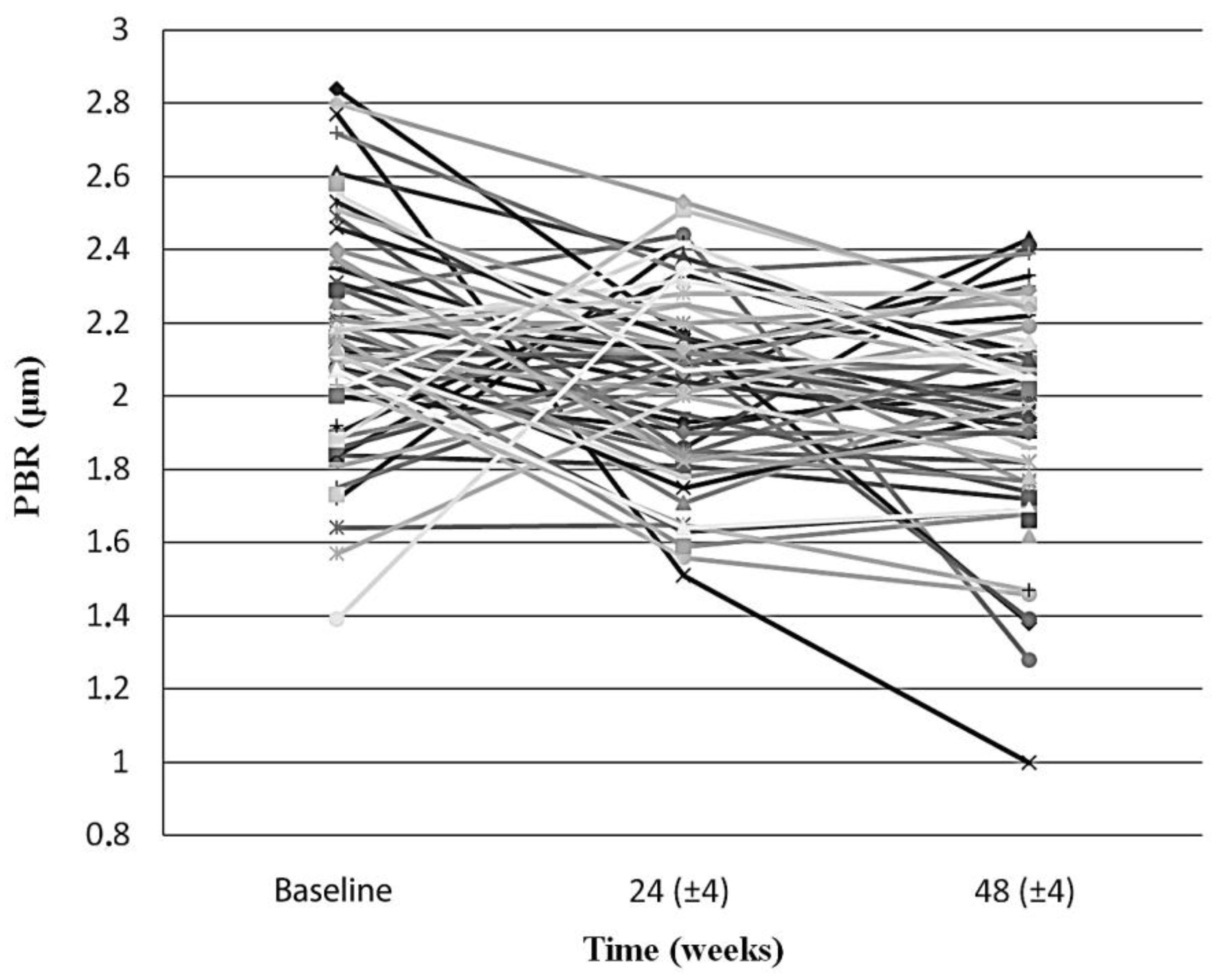
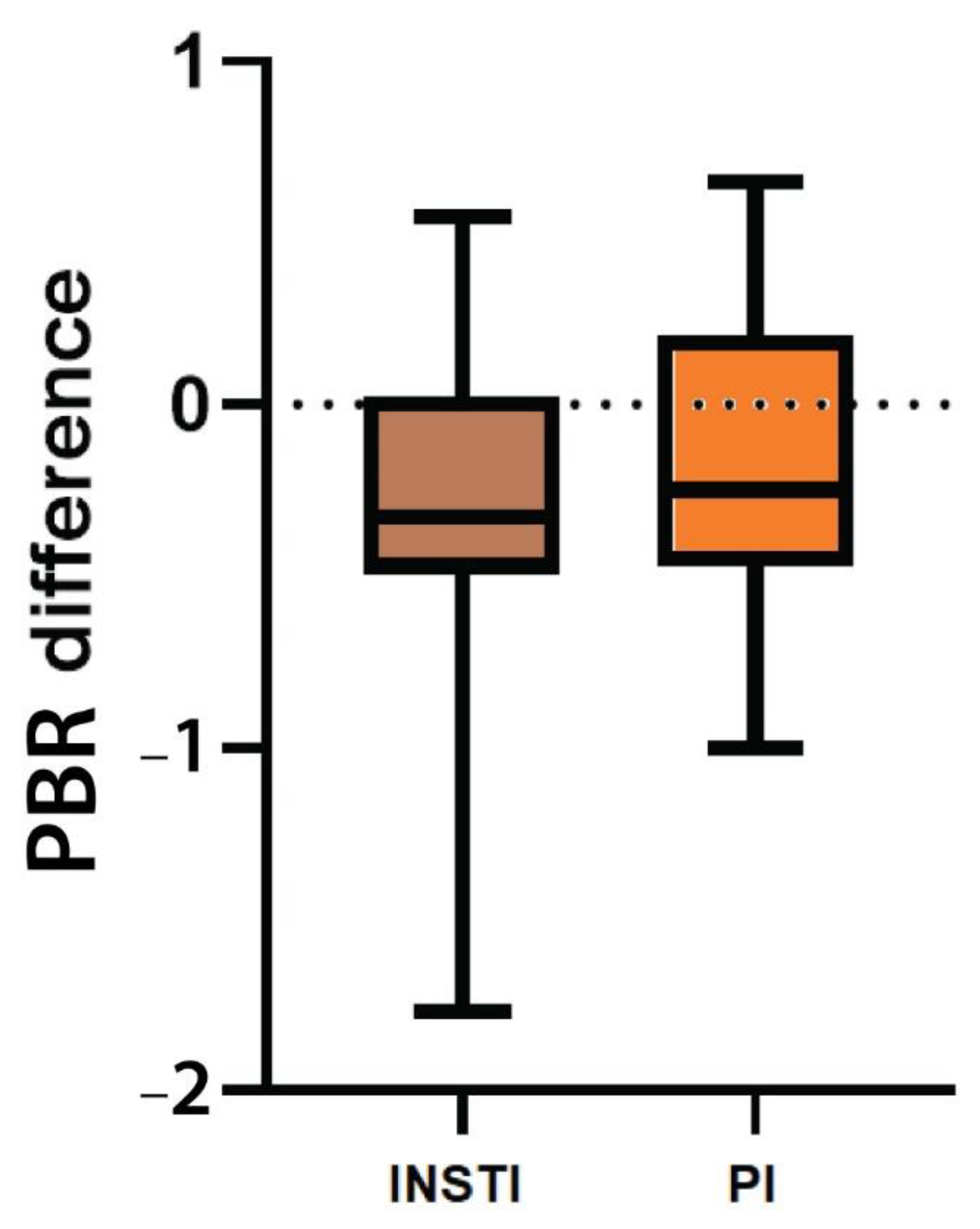
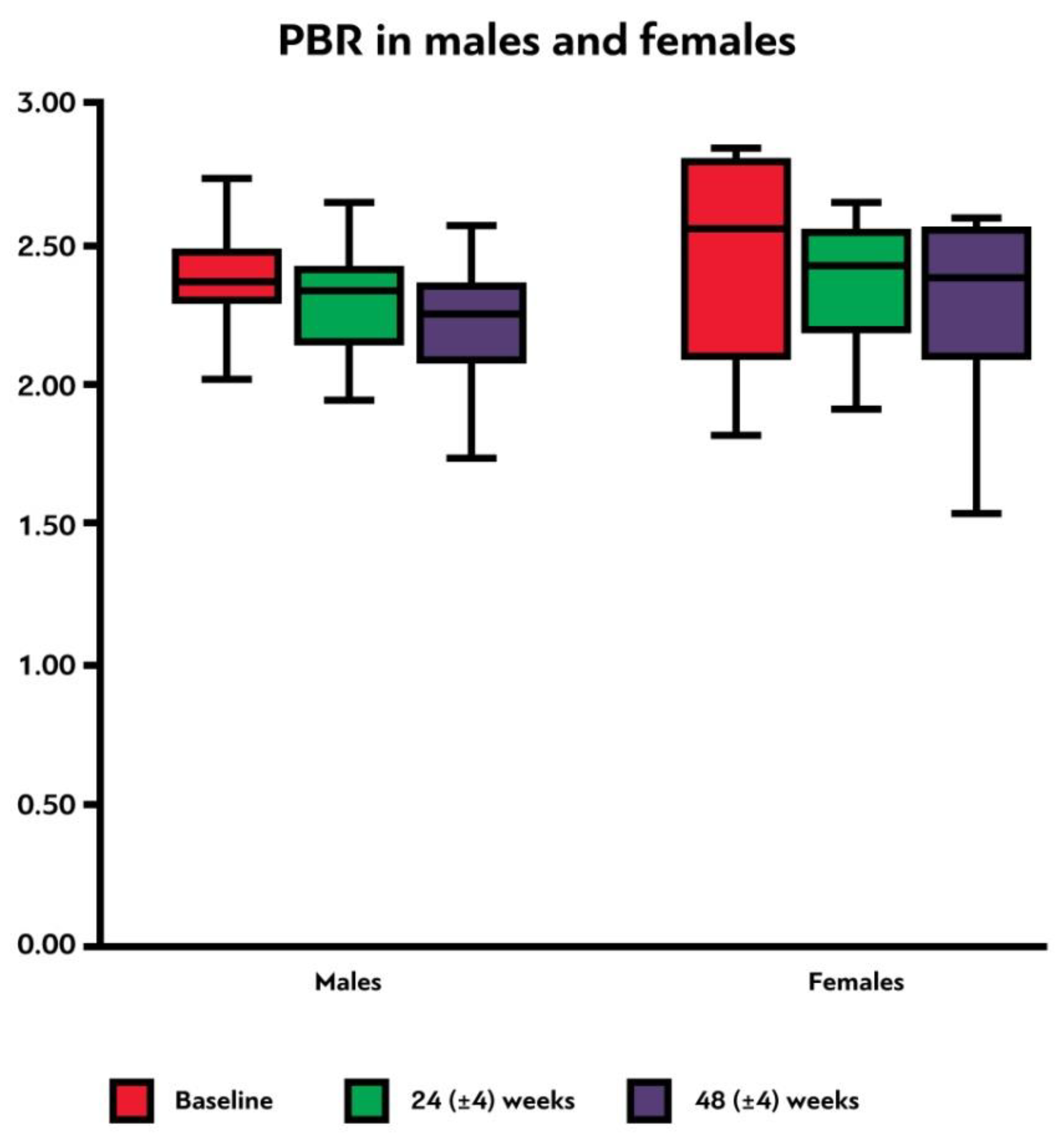
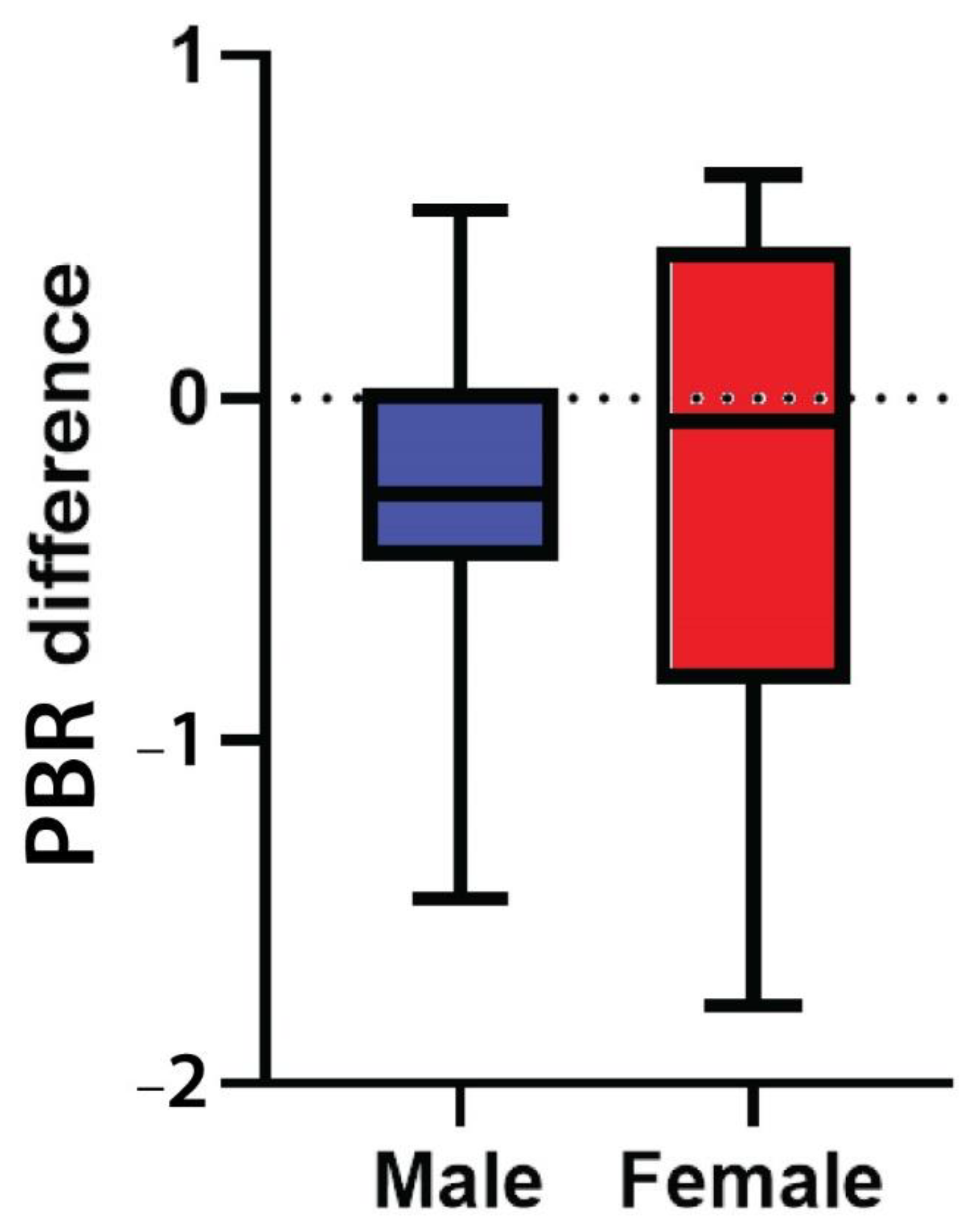
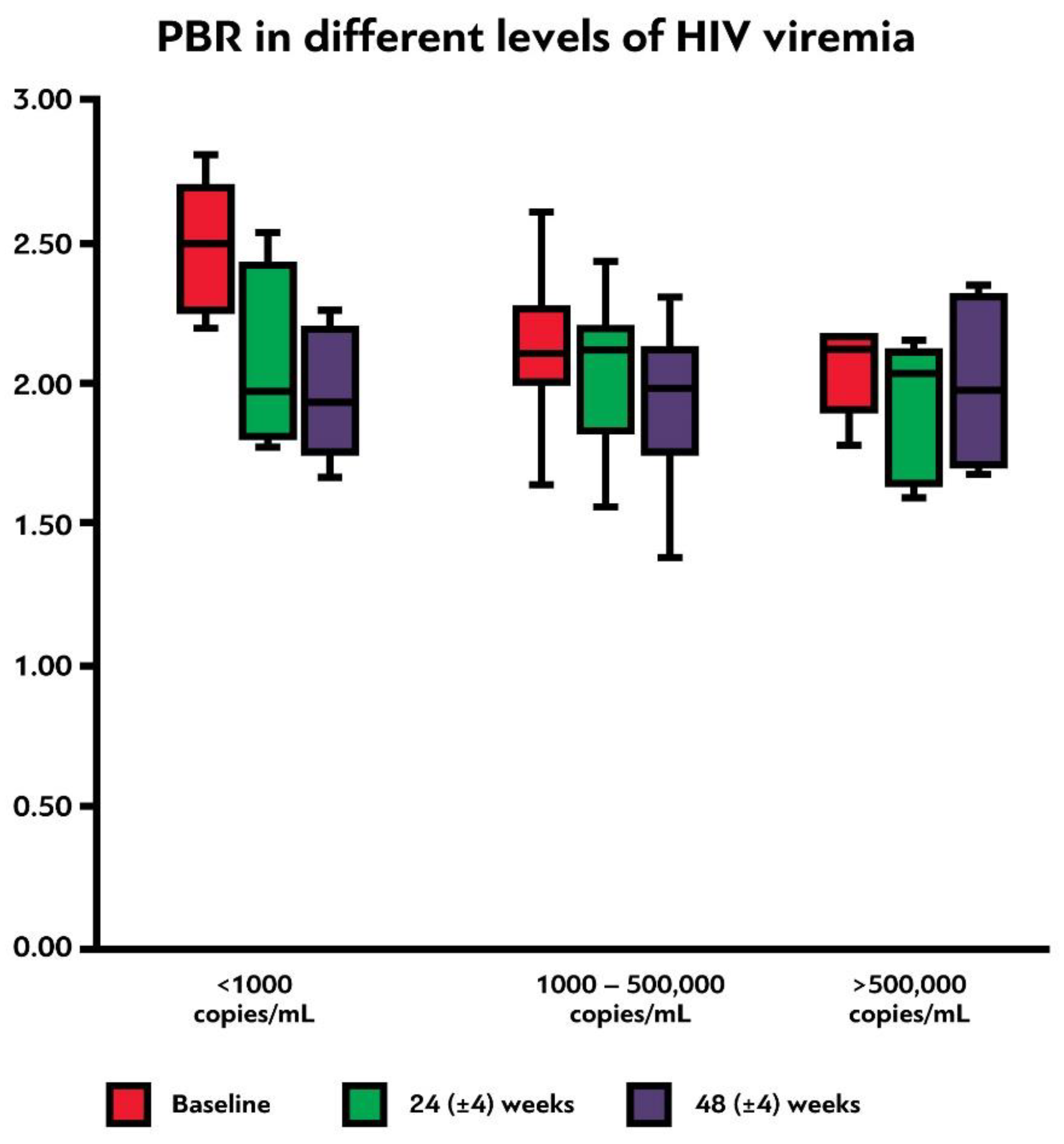
| GENERAL CHARACTERISTICS | |
|---|---|
| Sex (n (%)) | |
| Male | 60 (90.9) |
| Female | 6 (9.1) |
| Age (years) (median (IQR)) | 37 (12.0) |
| Antiretroviral regimen (n (%)) | |
| INSTIs | 40 (60.6) |
| DTG | 24 (36.4) |
| RAL | 7 (10.6) |
| EVG/c | 9 (13.6) |
| PI | 26 (39.4) |
| DRV/c | 26 (39.4) |
| HIV stage (n (%)) a | |
| Stage 1 | 7 (10.6) |
| Stage 2 | 42 (63.6) |
| Stage 3 | 17 (25.8) |
| Nadir CD4+ T-lymphocytes (cells/μL) (mean (SD)) | 377.9 (244.7) |
| Nadir CD4+ T-lymphocytes (cells/μL) (n (%)) | |
| <200 | 17 (25.8) |
| 200–500 | 29 (43.9) |
| >500 | 20 (30.3) |
| Peak viral load (copies/mL) (n (%)) b [Participants with available data: N = 53] | |
| <1000 | 5 (9.4) |
| 1000–500,000 | 41 (77.4) |
| >500,000 | 7 (13.2) |
| Race (n (%)) | |
| Caucasian | 61 (92.4) |
| African | 3 (4.6) |
| Other | 2 (3.0) |
| Mode of HIV transmission (n (%)) | |
| MSM | 41 (62.1) |
| Heterosexual | 21 (31.8) |
| IVDU | 3 (4.5) |
| Other/Unknown | 1 (1.5) |
| Educational stage (n (%)) | |
| Unknown | 3 (4.5) |
| Primary school | 7 (10.6) |
| Secondary school | 13 (19.7) |
| Higher education/University | 43 (65.2) |
| BMI (kg/m²) (median (IQR)) c | 24.2 (3.86) |
| TRADITIONAL CVD RISK FACTORS | |
| Smoking status (n (%)) c | |
| Yes | 40 (60.6) |
| No | 19 (28.8) |
| Ex smoker | 7 (10.6) |
| Family history of premature CVD (n (%)) | |
| Yes | 10 (15.2) |
| No | 56 (84.8) |
| Hypertension (n (%)) c | |
| Yes | 2 (3.0) |
| No | 64 (97.0) |
| Diabetes mellitus (n (%)) c | |
| Yes | 0 (0.0) |
| No | 66 (100.0) |
| Dyslipidemia (n (%)) c | |
| Yes | 3 (4.5) |
| No | 63 (95.5) |
| INSTIs N = 40 | PI N = 26 | p Value | |
|---|---|---|---|
| Age (years) (median (IQR)) | 37.0 (13.0) | 37.5 (13.0) | 0.595 |
| Sex (n (%)) | 0.202 | ||
| Male | 38 (95.0) | 22 (84.6) | |
| Female | 2 (5.0) | 4 (15.4) | |
| Smoking status (n (%)) * | 0.521 | ||
| Yes | 26 (65.0) | 14 (53.8) | |
| No | 11 (27.5) | 8 (30.8) | |
| Ex smoker | 3 (7.5) | 4 (15.4) | |
| LDL-c (mg/dL) (mean (SD)) * | 119.6 (40) | 105.4 (38.5) | 0.158 |
| HDL-c (mg/dL) (median (IQR)) * | 41.0 (14) | 38.0 (7) | 0.205 |
| Triglycerides (mg/dL) (median (IQR)) * | 91.0 (64) | 89.0 (70) | 0.634 |
| Body weight (kg) (mean (SD)) * | 74.2 (10.4) | 77.2 (16.7) | 0.417 |
| BMI (kg/m²) (mean (SD)) * | 24.0 (2.3) | 25.0 (5.5) | 0.397 |
| Nadir CD4+ T-lymphocytes (cells/μL) (mean (SD)) * | 412.5 (240.9) | 324.8 (245.6) | 0.157 |
| Viral load before cART initiation (copies/mL) (median (IQR)) * | 41,100 (228,020) | 111,000 (192,250) | 0.467 |
| Lost to follow up (n (%)) | - | ||
| 24 (±4) weeks | 4 (10.0) | 3 (11.5) | |
| 48 (±4) weeks | 3 (7.5) | 3 (11.5) |
| Subgroups | Median PBR5–25 (IQR) in μm at Baseline (95% CI) | Median PBR5–25 (IQR) in μm at 24 (±4) Weeks (95% CI) | Median PBR5–25 (IQR) in μm at 48(±4) Weeks (95% CI) | Median PBR5–25 (IQR) Difference in μm (95% CI) * |
|---|---|---|---|---|
| Sex | ||||
| Male | 2.13 (0.28) (2.09–2.22) | 2.08 (0.35) (1.96–2.10) | 1.96 (0.36) (1.85–1.99) | −0.28 (0.51) [(−0.35)–(−0.15)] |
| Female | 2.38 (0.98) (1.68–2.82) | 2.21 (0.50) (1.76–2.50) | 2.15 (0.64) (1.46–2.58) | −0.07 (1.27) [(−1.15)–(+0.68)] |
| Nadir CD4+ count (cells/μL) | ||||
| <200 | 2.21 (0.40) (2.02–2.40) | 2.13 (0.30) (1.96–2.26) | 2.11 (0.40) (1.86–2.22) | −0.15 (0.68) [(−0.39)–(+0.04)] |
| 200–500 | 2.07 (0.20) (1.96–2.21) | 2.03 (0.50) (1.91–2.18) | 1.97 (0.33) (1.85–2.05) | −0.28 (0.57) [(−0.33)–(−0.01)] |
| >500 | 2.24 (0.68) (2.05–2.45) | 2.11 (0.36) (1.87–2.19) | 1.97 (0.34) (1.71–2.08) | −0.33 (0.55) [(−0.67)–(−0.11)] |
| Initial viral load (copies/mL) | ||||
| <1000 | 2.52 (0.37) (2.26–2.71) | 1.96 (0.62) (1.52–2.59) | 1.92 (0.45) (1.66–2.24) | −0.56 (0.30) [(−0.71)–(−0.31)] |
| 1000–500,000 | 2.11 (0.37) (2.01–2.21) | 2.12 (0.45) (1.98–2.15) | 2.01 (0.33) (1.87–2.05) | −0.18 (0.52) [(−0.31)–(−0.06)] |
| >500,000 | 2.12 (0.27) (1.85–2.34) | 2.06 (0.49) (1.57–2.23) | 1.94 (0.62) (1.66–2.29) | −0.12 (0.93) [(−0.67)–(+0.45)] |
| Smoking Status | ||||
| Smokers | 2.17 (0.22) (2.10–2.26) | 2.03 (0.42) (1.87–2.08) | 1.89 (0.39) (1.77–1.99) | −0.37 (0.53) [(−0.44)–(−0.17)] |
| Non-smokers | 2.13 (0.53) (1.99–2.36) | 2.10 (0.35) (1.98–2.26) | 2.05 (0.19) (1.91–2.18) | −0.27 (0.73) [(−0.45)–(+0.03)] |
| Ex smokers | 2.02 (0.32) (1.82–2.25) | 2.33 (0.51) (1.87–2.59) | 2.08 (0.29) (1.93–2.31) | −0.04 (0.39) [(−0.23)–(+0.26)] |
| Illicit drug use | ||||
| Yes | 2.12 (0.21) (1.99–2.21) | 1.96 (0.51) (1.82–2.17) | 1.89 (0.45) (1.71–2.02) | −0.33 (0.54) [(−0.40)–(−0.11)] |
| No | 2.22 (0.36) (2.10–2.29) | 2.12 (0.41) (1.99–2.18) | 2.01 (0.28) (1.91–2.09) | −0.12 (0.57) [(−0.40)–(−0.05)] |
Disclaimer/Publisher’s Note: The statements, opinions and data contained in all publications are solely those of the individual author(s) and contributor(s) and not of MDPI and/or the editor(s). MDPI and/or the editor(s) disclaim responsibility for any injury to people or property resulting from any ideas, methods, instructions or products referred to in the content. |
© 2023 by the authors. Licensee MDPI, Basel, Switzerland. This article is an open access article distributed under the terms and conditions of the Creative Commons Attribution (CC BY) license (https://creativecommons.org/licenses/by/4.0/).
Share and Cite
Fragkou, P.C.; Ikonomidis, I.; Benas, D.; Kavatha, D.; Moschopoulos, C.D.; Protopapas, K.; Kostelli, G.; Thymis, J.; Mpirmpa, D.; Galani, I.; et al. Endothelial Glycocalyx Integrity in Treatment-Naïve People Living with HIV before and One Year after Antiretroviral Treatment Initiation. Viruses 2023, 15, 1505. https://doi.org/10.3390/v15071505
Fragkou PC, Ikonomidis I, Benas D, Kavatha D, Moschopoulos CD, Protopapas K, Kostelli G, Thymis J, Mpirmpa D, Galani I, et al. Endothelial Glycocalyx Integrity in Treatment-Naïve People Living with HIV before and One Year after Antiretroviral Treatment Initiation. Viruses. 2023; 15(7):1505. https://doi.org/10.3390/v15071505
Chicago/Turabian StyleFragkou, Paraskevi C., Ignatios Ikonomidis, Dimitrios Benas, Dimitra Kavatha, Charalampos D. Moschopoulos, Konstantinos Protopapas, Gavriella Kostelli, John Thymis, Dionysia Mpirmpa, Irene Galani, and et al. 2023. "Endothelial Glycocalyx Integrity in Treatment-Naïve People Living with HIV before and One Year after Antiretroviral Treatment Initiation" Viruses 15, no. 7: 1505. https://doi.org/10.3390/v15071505
APA StyleFragkou, P. C., Ikonomidis, I., Benas, D., Kavatha, D., Moschopoulos, C. D., Protopapas, K., Kostelli, G., Thymis, J., Mpirmpa, D., Galani, I., Tsakona, M., Oikonomopoulou, C., Theocharous, G., Gorgoulis, V. G., Gallos, P., Tsiodras, S., Antoniadou, A., Papadopoulos, A., & Triantafyllidi, H. (2023). Endothelial Glycocalyx Integrity in Treatment-Naïve People Living with HIV before and One Year after Antiretroviral Treatment Initiation. Viruses, 15(7), 1505. https://doi.org/10.3390/v15071505














